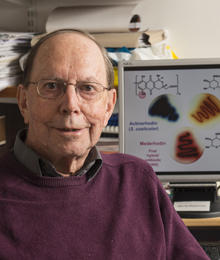An interview with Professor Sir David Hopwood, FRS
May 2020
Professor Sir David Hopwood FRS is Emeritus Fellow at the Department of Molecular Microbiology at the John Innes Centre. He has been a member of the Microbiology Society since 1955, was awarded honorary membership in 1990 and President of the Microbiology Society 2000–2003. In this interview he tells us more about his research career and why it is important to be part of a membership charity such as the Microbiology Society.

How did you become a microbiologist?
Graduating in botany at Cambridge in 1954, I decided to go into genetics research. Microbes, with their small size and short generation time, were becoming prime subjects for elucidating the structure and mode of action of genes, so I became a microbiologist by default.
Tell us about your research career.
My PhD investigated the genetics of an actinomycete, then thought to be intermediate between bacteria and fungi. It was already clear that genetic exchange was fundamentally different between pro- and eukaryotes so a truly intermediate group would be a revealing missing link. I discovered that members of the genus Streptomyces, the most important actinomycetes, were true bacteria, but with a conjugation mechanism and chromosome topology, very different from what became the E. coli paradigm for bacterial mating.
How did you get into natural product research?
Streptomycetes were known from the 1950s to be prolific antibiotic producers, but nothing was known of the genetic basis of this amazing chemistry. My chosen organism, Streptomyces coelicolor, produces a beautiful blue antibiotic called actinorhodin so we could use its colour to pick mutants blocked at different points in its biosynthesis. Mapping them, using the conjugation system I had established, showed that the set of genes encoding the entire biosynthesis and its regulation were clustered together on the chromosome. This clustering turned out to be the rule for all antibiotic biosynthesis, in fungi as well as bacteria, greatly aiding the subsequent analysis and manipulation of the genes.
What were the eureka moments in your research?
Seeing a purple culture arising from the cloning of genes from the producer of blue actinorhodin into a strain making a brown compound told us that we had made the world’s first hybrid antibiotic. That 1985 result was the catalyst for the introduction of genetic approaches that transformed natural product chemistry. A second major thrill was the completion of the genome sequence of S. coelicolor at the Sanger Institute in 2001 using the set of overlapping chromosome fragments that we and our collaborators had made.
It had taken four years and two million pounds in those days, but it revealed an Aladdin’s cave of information, including the discovery that the organism has the genetic potential to produce a couple of dozen specialised metabolites, most not made in lab conditions. This turns out to be the general rule, so the challenge now is to find ways to wake up such sleeping genes to allow the resulting compounds to be evaluated as weapons in the urgent fight to overcome the menace of antimicrobial resistance.
Why is it important to be a member of an organisation like the Microbiology Society?
Being a member for 65 of its 75 years, I owe much to the Society. It was the main way of learning about microbiology, especially early in my career. I gave my first talk at the Society for General Microbiology (SGM) in 1956 and contributed to many later meetings, including to the wonderful annual published Symposia of those days. I was glad to give something back when I had the honour of being President of the Society from 2000 to 2003.
Tell us a little about your educational and outreach activities.
As a young academic in Cambridge and later in Glasgow I had organised practical classes, but it was only in Norwich, as Professor of Genetics at the University of East Anglia and Head of the Genetics Department at the John Innes Centre, that I began to give lectures and got a great kick out of teaching genetics to undergraduates. I believe research scientists should do at least a little teaching to keep their feet on the ground by facing the questioning of the younger generation. In the 1980s my colleagues and I ran European Molecular Biology Organization (EMBO) practical courses on Streptomyces genetics for PhD students and postdocs from all over Europe, which I found very stimulating and helped to spread interest in the field. In 2007, with a Croatian colleague, we started a series of summer schools in Dubrovnik on microbial specialised metabolites for participants from all over the world, which are still ongoing. They have provided some of the most abiding memories of my career.
Why does microbiology matter?
Microbial specialised metabolites, especially antibiotics but also compounds like immunosuppressants and statins, have absolutely transformed medicine. Without microbiology we would have none of these wonderful gifts of nature.


